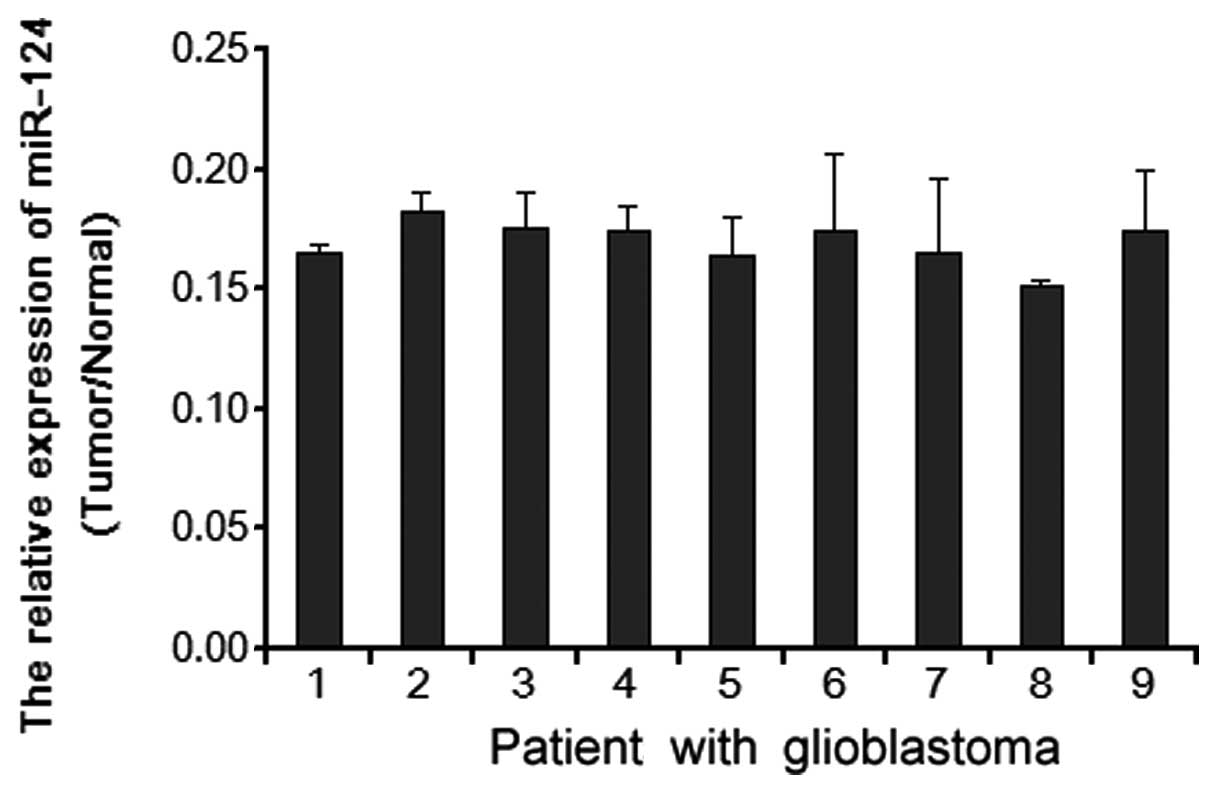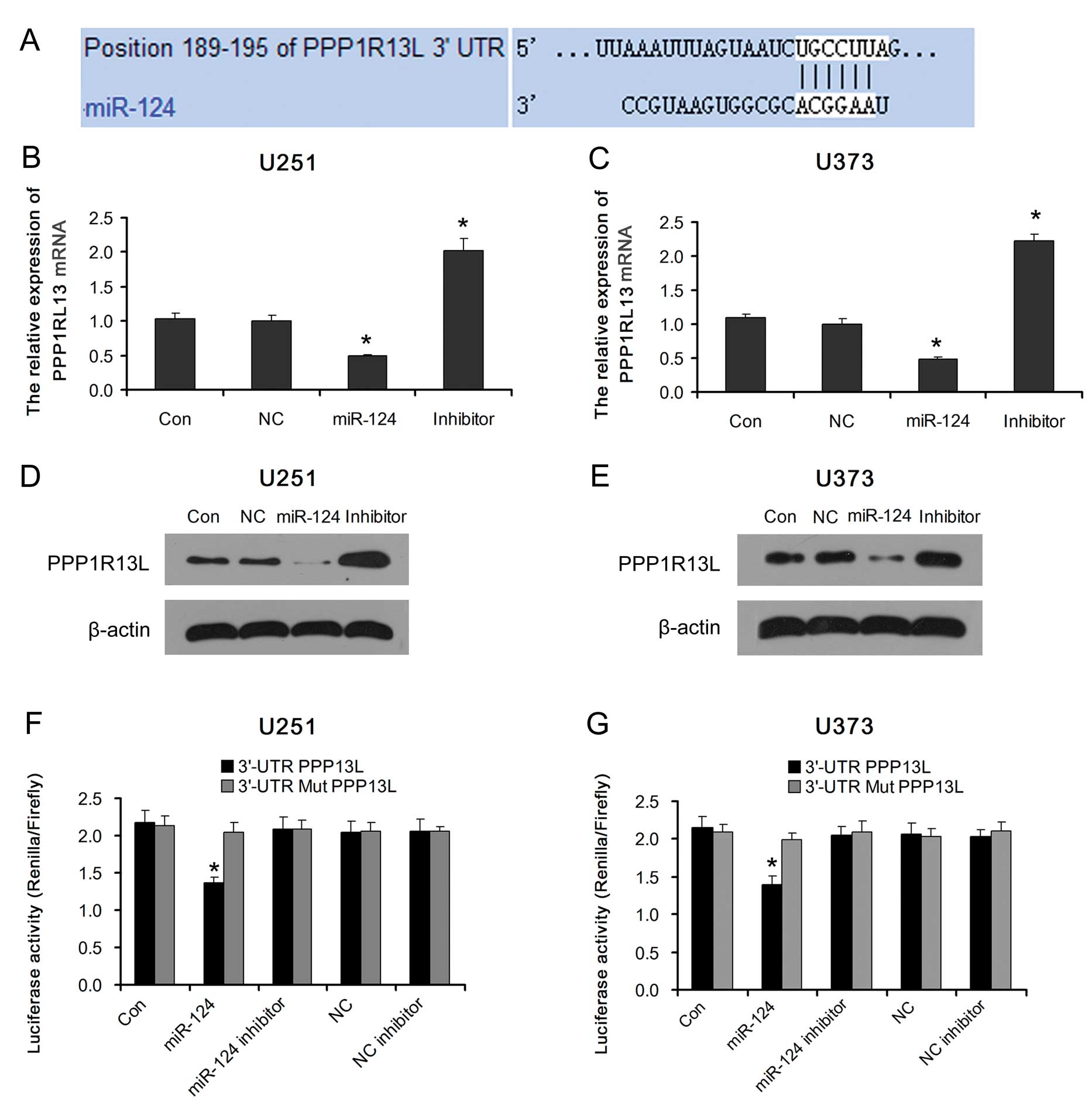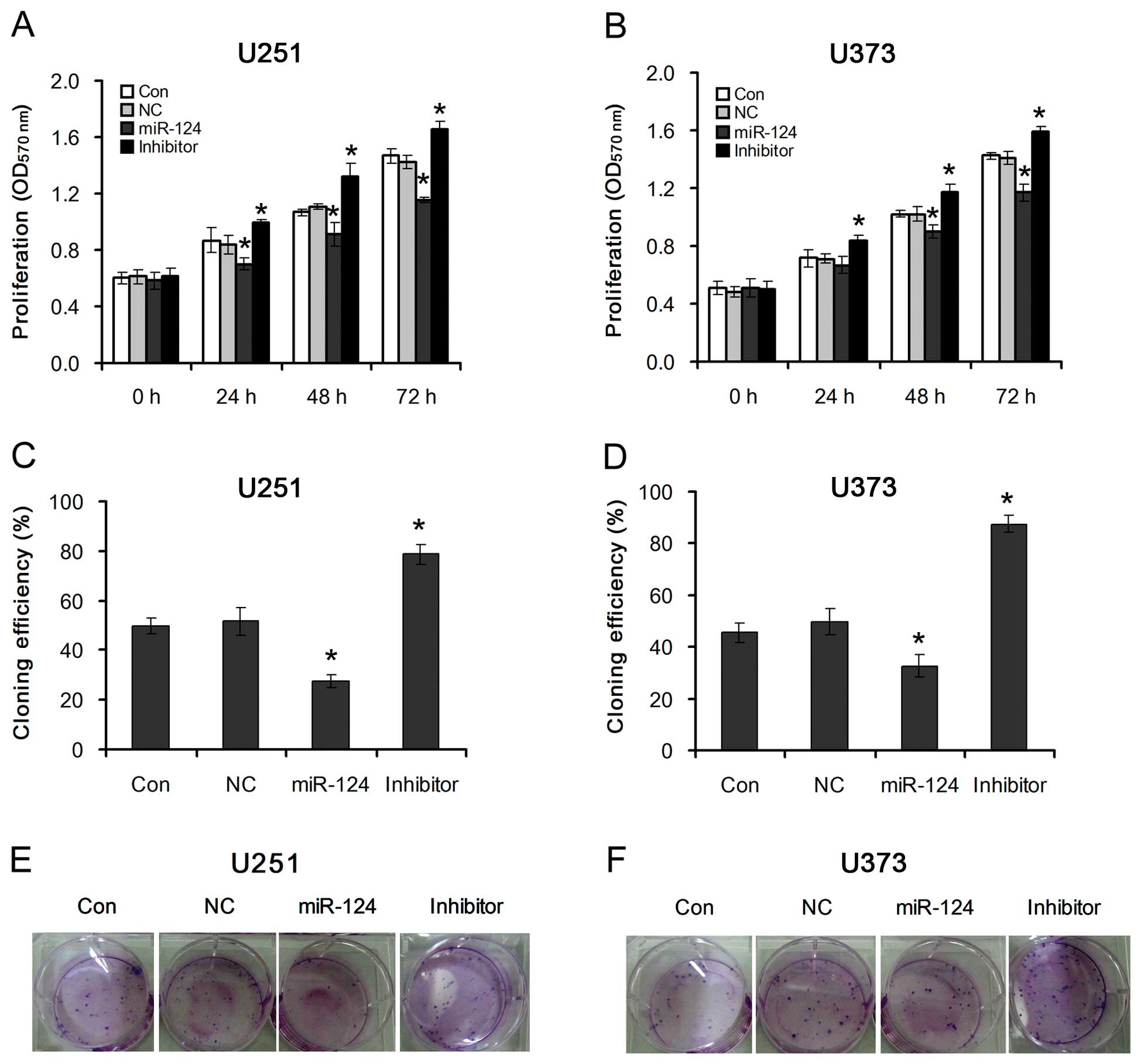|
1.
|
Baldi I, Huchet A, Bauchet L and Loiseau
H: Epidemiology of glioblastoma. Neurochirurgie. 56:433–440. 2010.
View Article : Google Scholar : PubMed/NCBI
|
|
2.
|
Preusser M, de Ribaupierre S, Wöhrer A, et
al: Current concepts and management of glioblastoma. Ann Neurol.
70:9–21. 2011. View Article : Google Scholar
|
|
3.
|
Lang MF, Yang S, Zhao C, et al:
Genome-wide profiling identified a set of miRNAs that are
differentially expressed in glioblastoma stem cells and normal
neural stem cells. PLoS One. 7:e362482012. View Article : Google Scholar : PubMed/NCBI
|
|
4.
|
Skalsky RL and Cullen BR: Reduced
expression of brain-enriched microRNAs in glioblastomas permits
targeted regulation of a cell death gene. PLoS One. 6:e242482011.
View Article : Google Scholar : PubMed/NCBI
|
|
5.
|
Sun Y, Zhao X, Zhou Y and Hu Y: miR-124,
miR-137 and miR-340 regulate colorectal cancer growth via
inhibition of the Warburg effect. Oncol Rep. 28:1346–1352.
2012.PubMed/NCBI
|
|
6.
|
Blenkiron C and Miska EA: miRNAs in
cancer: approaches, aetiology, diagnostics and therapy. Hum Mol
Genet. 16:R106–R113. 2007. View Article : Google Scholar : PubMed/NCBI
|
|
7.
|
Li Y, Zhao S, Zhen Y, et al: A miR-21
inhibitor enhances apoptosis and reduces G(2)-M accumulation
induced by ionizing radiation in human glioblastoma U251 cells.
Brain Tumor Pathol. 28:209–214. 2011. View Article : Google Scholar : PubMed/NCBI
|
|
8.
|
Cortez MA, Nicoloso MS, Shimizu M, et al:
miR-29b and miR-125a regulate podoplanin and suppress invasion in
glioblastoma. Genes Chromosomes Cancer. 49:981–990. 2010.
View Article : Google Scholar : PubMed/NCBI
|
|
9.
|
Chen L, Wang X, Wang H, et al: miR-137 is
frequently down-regulated in glioblastoma and is a negative
regulator of Cox-2. Eur J Cancer. 48:3104–3111. 2012. View Article : Google Scholar : PubMed/NCBI
|
|
10.
|
Wu Z, Sun L, Wang H, et al: MiR-328
expression is decreased in high-grade gliomas and is associated
with worse survival in primary glioblastoma. PLoS One.
7:e472702012. View Article : Google Scholar : PubMed/NCBI
|
|
11.
|
Liu Y, Yan W, Zhang W, et al: MiR-218
reverses high invasiveness of glioblastoma cells by targeting the
oncogenic transcription factor LEF1. Oncol Rep. 28:1013–1021.
2012.PubMed/NCBI
|
|
12.
|
Li D, Chen P, Li XY, et al: Grade-specific
expression profiles of miRNAs/mRNAs and docking study in human
grade I–III astrocytomas. OMICS. 15:673–682. 2011.PubMed/NCBI
|
|
13.
|
Li KK, Pang JC, Ching AK, et al: miR-124
is frequently down-regulated in medulloblastoma and is a negative
regulator of SLC16A1. Hum Pathol. 40:1234–1243. 2009. View Article : Google Scholar : PubMed/NCBI
|
|
14.
|
Silber J, Lim DA, Petritsch C, et al:
miR-124 and miR-137 inhibit proliferation of glioblastoma
multiforme cells and induce differentiation of brain tumor stem
cells. BMC Med. 6:142008. View Article : Google Scholar : PubMed/NCBI
|
|
15.
|
Pierson J, Hostager B, Fan R and Vibhakar
R: Regulation of cyclin-dependent kinase 6 by microRNA 124 in
medulloblastoma. J Neurooncol. 90:1–7. 2008. View Article : Google Scholar : PubMed/NCBI
|
|
16.
|
Xie YK, Huo SF, Zhang G, et al: CDA-2
induces cell differentiation through suppressing Twist/SLUG
signaling via miR-124 in glioma. J Neurooncol. 110:179–186. 2012.
View Article : Google Scholar : PubMed/NCBI
|
|
17.
|
Xia H, Cheung WK, Ng SS, et al: Loss of
brain-enriched miR-124 microRNA enhances stem-like traits and
invasiveness of glioma cells. J Biol Chem. 287:9962–9971. 2012.
View Article : Google Scholar : PubMed/NCBI
|
|
18.
|
Cai Y, Qiu S, Gao X, Gu SZ and Liu ZJ:
iASPP inhibits p53-independent apoptosis by inhibiting
transcriptional activity of p63/p73 on promoters of proapoptotic
genes. Apoptosis. 17:777–783. 2012. View Article : Google Scholar : PubMed/NCBI
|
|
19.
|
Alsafadi S, Tourpin S, André F, Vassal G
and Ahomadegbe JC: P53 family: at the crossroads in cancer therapy.
Curr Med Chem. 16:4328–4344. 2009. View Article : Google Scholar : PubMed/NCBI
|
|
20.
|
Bergamaschi D, Samuels Y, Sullivan A, et
al: iASPP preferentially binds p53 proline-rich region and
modulates apoptotic function of codon 72-polymorphic p53. Nat
Genet. 38:1133–1141. 2006. View
Article : Google Scholar : PubMed/NCBI
|
|
21.
|
Chen J, Xie F, Zhang L and Jiang WG: iASPP
is over-expressed in human non-small cell lung cancer and regulates
the proliferation of lung cancer cells through a p53 associated
pathway. BMC Cancer. 10:6942010. View Article : Google Scholar : PubMed/NCBI
|
|
22.
|
Lu B, Guo H, Zhao J, et al: Increased
expression of iASPP, regulated by hepatitis B virus X
protein-mediated NF-κB activation, in hepatocellular carcinoma.
Gastroenterology. 139:2183–2194. 2010.PubMed/NCBI
|
|
23.
|
Zhang X, Wang M, Zhou C, Chen S and Wang
J: The expression of iASPP in acute leukemias. Leuk Res.
29:179–183. 2005. View Article : Google Scholar : PubMed/NCBI
|
|
24.
|
Pang MS, Chen X, Lu B, et al: Lentiviral
vector-mediated doxycycline-inducible iASPP gene targeted RNA
interference in hepatocellular carcinoma. Chin J Cancer.
29:796–801. 2010. View Article : Google Scholar : PubMed/NCBI
|
|
25.
|
Lin BL, Xie DY, Xie SB, et al:
Down-regulation of iASPP in human hepatocellular carcinoma cells
inhibits cell proliferation and tumor growth. Neoplasma.
58:205–210. 2011. View Article : Google Scholar : PubMed/NCBI
|
|
26.
|
Liu Z, Zhang X, Huang D, et al: Elevated
expression of iASPP in head and neck squamous cell carcinoma and
its clinical significance. Med Oncol. 29:3381–3388. 2012.
View Article : Google Scholar : PubMed/NCBI
|
|
27.
|
Jiang L, Siu MK, Wong OG, et al: iASPP and
chemoresistance in ovarian cancers: effects on paclitaxel-mediated
mitotic catastrophe. Clin Cancer Res. 17:6924–6933. 2011.
View Article : Google Scholar : PubMed/NCBI
|
|
28.
|
Li G, Wang R, Gao J, Deng K, Wei J and Wei
Y: RNA interference-mediated silencing of iASPP induces cell
proliferation inhibition and G0/G1 cell cycle
arrest in U251 human glioblastoma cells. Mol Cell Biochem.
350:193–200. 2011. View Article : Google Scholar : PubMed/NCBI
|
|
29.
|
Arocho A, Chen B, Ladanyi M and Pan Q:
Validation of the 2-DeltaDeltaCt calculation as an alternate method
of data analysis for quantitative PCR of BCR-ABL P210 transcripts.
Diagn Mol Pathol. 15:56–61. 2006.PubMed/NCBI
|
|
30.
|
Aspenström P, Fransson A and Saras J: Rho
GTPases have diverse effects on the organization of the actin
filament system. Biochem J. 377:327–337. 2004.PubMed/NCBI
|
|
31.
|
Shi XB, Xue L, Ma AH, et al: Tumor
suppressive miR-124 targets androgen receptor and inhibits
proliferation of prostate cancer cells. Oncogene. Oct 15–2012.(Epub
ahead of print). View Article : Google Scholar
|
|
32.
|
Liu T, Li L, Yang W, et al: iASPP is
important for bladder cancer cell proliferation. Oncol Res.
19:125–130. 2011. View Article : Google Scholar : PubMed/NCBI
|
|
33.
|
Zhang B, Xiao HJ, Chen J, Tao X and Cai
LH: Inhibitory member of the apoptosis-stimulating protein of p53
(ASPP) family promotes growth and tumorigenesis in human
p53-deficient prostate cancer cells. Prostate Cancer Prostatic Dis.
14:219–224. 2011. View Article : Google Scholar : PubMed/NCBI
|
|
34.
|
Liu WK, Jiang XY, Ren JK and Zhang ZX:
Expression pattern of the ASPP family members in endometrial
endometrioid adenocarcinoma. Onkologie. 33:500–503. 2010.
View Article : Google Scholar : PubMed/NCBI
|
|
35.
|
Laska MJ, Lowe SW, Zender L, et al:
Enforced expression of PPP1R13L increases tumorigenesis and
invasion through p53-dependent and p53-independent mechanisms. Mol
Carcinog. 48:832–842. 2009. View
Article : Google Scholar : PubMed/NCBI
|














